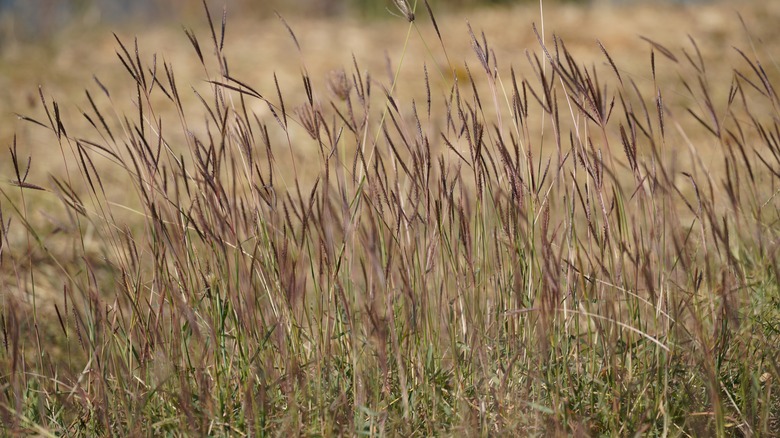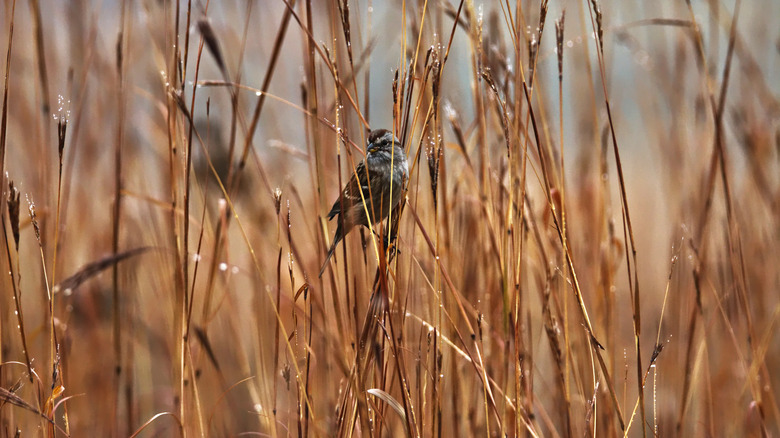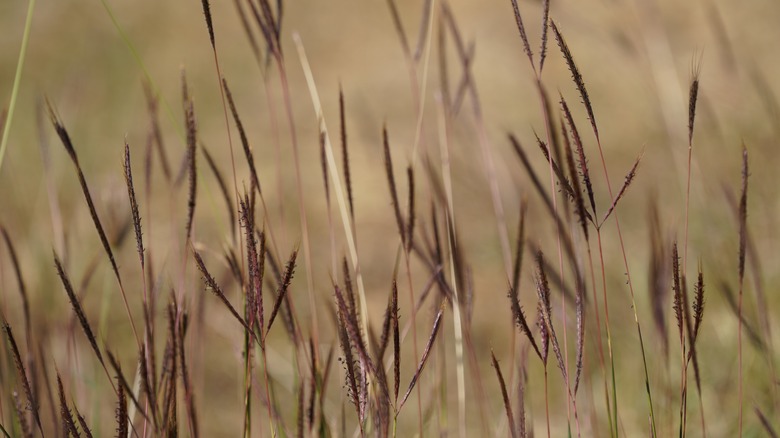The Benefits And Drawbacks Of Planting Big Bluestem Grass
Creating the perfect backyard or garden may seem simple at face value, but in reality, it requires you to consider several factors, like the climate you live in and your overall aesthetic goals. Big bluestem grass (Andropogon gerardii), also referred to as "turkeyfoot" due to its seedhead with three golden-brown projections, is a beautiful, showy grass species that adds new visual interest with each season. In the spring, the foliage brightens your yard with an attractive bluish-green shade. By summer, the plant bears 2 to 4 inch-long purplish or yellowish flowers, though the bright green grass stalks are the real stars of the show, offering a stunning backdrop for other prairie blooms. However, this prairie grass is more than just good looks; it's an easy-to-grow native species that benefits your yard and provides habitat for wildlife.
However, there are some drawbacks to planting big bluestem grass, which you should consider before growing it in your yard. Because although it's easy to grow, managing this plant can take some effort, as trimming it at the wrong time could lead to its demise. Additionally, although picturesque, this aptly named species grows 6 to 8 feet tall, which may not be suitable for all landscaping goals. Understanding the pros and cons of this ornamental grass will help you determine if it's the right choice for your landscape. So, let's get into everything you need to know about big bluestem grass.
Benefits of adding big bluestem grass to your yard
If you're someone who tends to forget to water the lawn, big bluestem grass may be the perfect ornamental grass for your yard. Established plants are extremely drought-tolerant, and typically, occasional rain will be enough to keep this plant happy, though supplemental showers during long, dry periods will keep it looking its best. As long as it receives plenty of sun and low moisture, this hardy species can handle nearly any condition in your yard. Big bluestem grass grows well in most well-draining soil types, even happily growing in low-fertility soils. The deep root system of big bluestem makes it ideal for areas prone to erosion.
Not only is this native species beneficial for your yard, it provides shelter for a variety of animals. It's a considerable choice for those with livestock who will enjoy grazing. Even if you don't live on a farm, big bluestem is perfect for anyone wanting to attract more wildlife. Ground-nesting birds, like bobwhite quail, love using this plant to build their nests. Birds and other small animals use this grass for cover, especially during the winter. Big bluestem also brings more pollinators into your yard and garden. Several butterfly species lay their eggs on this grass, and caterpillars enjoy munching on the leaves. Other insects, like grasshoppers, also find this plant to be a delicious snack. Deer, on the other hand, tends to stay away from it.
Potential drawbacks of planting big bluestem grass
Although there are advantages to adding ornamental grass to your landscaping, there are some potential drawbacks depending on your yard and overall goals. Big bluestem grass can be pricey, and it may take years to establish. Once it does, if you have a smaller yard or garden, this massively tall grass may be a bit overwhelming visually and to neighboring plants. Growing up to 8 feet in height, it could cast a lot of shade on shorter plants, making it nearly impossible for species requiring full sun to thrive. It's not a good idea to cut it during the growing season either, as cutting it repeatedly could kill your grass. To remedy this, plant big bluestem in an area that doesn't cast shade on your garden, opt for container plantings, or place it next to shade-loving companion plants.
This grass may be hardy, but excess shade, moisture, or fertilizer can cause big bluestem to become too top-heavy and spill over. If this happens, you'll need to improve the conditions or transplant the plant to a more suitable area. Alternatively, in excellent conditions, this species can be quite an aggressive grower that rapidly self-seeds and spreads through underground rhizomes. So, if you don't cut back the plant at the end of the growing season, it could quickly take over your entire yard. However, if you're able to keep up with the required maintenance, the benefits of big bluestem grass sometimes outweigh the drawbacks.


